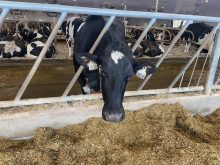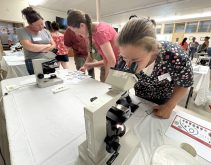The stakes are high in the battle to hold the line on antimicrobial resistance.
It’s a fight that’s happening globally, in hospitals, pharmacies, veterinarian offices and farms.
Why it matters: Antimicrobial resistance threatens both livestock and human health. Policies in the last decade have tightened farmer access to antibiotics and changed how people are prescribed products as well.
Read Also

Back to the drawing board for sexed semen fertility ratings
Lactanet, the national genetic evaluation and dairy data provider, goes back to the drawing board with its sexed semen fertility rating index prototype.
In Canadian laboratories, microbiologist Dominique Poulon-Laprade is one of the people on the front line, working to understand and combat how bacteria, viruses, fungi and parasites overcome the drugs that previously controlled them.
“AMR is everywhere, in and on everything and everyone, and it has a major impact on our health — or maybe should I say our death — as well as on our economy,” Poulon-Laprade said.
Canada is at the halfway point of a five-year federal research commitment on antimicrobial resistance.
The Genomics Research and Development Initiative on Antimicrobial Resistance (GRDI AMR) is scheduled to run from 2023 to 2027. It brings together researchers from multiple federal departments, including Poulon-Laprade.
She outlined that initiative during a virtual symposium hosted by Agriculture and Agri-Food Canada’s Sherbrooke Research and Development Centre on June 10.
Unlike diseases that affect only humans or animals, antimicrobial resistance spreads across what scientists call the “One Health continuum” — the interconnected web of human, animal, plant and environmental health, the researcher said.
Poulon-Laprade described the connections as more complex than “a spider web.”
That complexity is why GRDI AMR involves over 40 federal scientists and their teams working across sectors, she noted. Stakeholders span human health, livestock, aquaculture, agriculture, and Canadian environments ranging from urban centers to wilderness areas.
Following international commitments
The initiative stems from Canada’s international political commitments and declarations on antimicrobial resistance.
Canada is currently following the Pan-Canadian Action Plan on Antimicrobial Resistance, which was released in 2023, and looking to address recommendations made by the auditor general of Canada on the subject.
That pan-Canadian plan outlines five action pillars, including research and innovation, which supports funding for GRDI AMR, among other grants to scientists outside the federal government.
Other pillars include surveillance, stewardship, infection prevention and leadership.
The federal government is also developing a national One Health antimicrobial research strategy and an environmental surveillance strategy to guide future research.
One funding program, multiple health sectors
What sets the GRDI AMR initiative apart from other Canadian research funding programs is its integrated approach, Poulon-Laprade said. Unlike traditional funding programs that are divided by sector, GRDI AMR provides funding within a single project for researchers from various sectors.
“GRDI AMR is one of the few funding opportunities that is truly One Health by nature,” she added.
All said, the consortium now includes hundreds of people, working across 25 sub-projects and organized into six work packages. Scientists map the development and mitigation efforts of antimicrobial resistance, and use that information to identify areas where action can be taken.
The team’s triumphs so far include developing flexible umbrella agreements that allow data and sample sharing, standardized methods to reduce bias, and centralized computing systems to analyze data better.
Real-world discoveries
One example of GRDI AMR work is its research into Klebsiella bacteria, which has developed strains resistant to multiple drugs and can be hyper-virulent, making it bad news for hospital outbreaks and severe community spread.
That pathogen is “an urgent threat to human health,” Poulon-Laprade noted.
Over 50 genetic lineages were identified during a study involving more than 800 Klebsiella strains, which were gathered across sectors like food, livestock, environment and water sources. There was a troubling overlap in how those genetic types were found across sectors, she said. One particular strain type, ST432, was found in food, cattle and environmental samples in Canada.
It has also been recovered from human clinical settings in South Africa and Malawi, as well as from diseased pigs in England and the West Indies, “so it’s very global,” Poulon-Laprade said.
GRDI AMR research also confirmed fears about the bacteria’s resistance. Most strains were found to carry multiple genes linked to antibiotic resistance. Many carried genes for beta-lactamases — enzymes that break down beta-lactam antibiotics that clinicians and veterinarians rely on daily.
Perhaps most concerning, she believes, is that researchers found instances of carbapenemase genes, which produce enzymes that destroy last-line antibiotics — the drugs doctors turn to when all else fails.
The future of GRDI AMR
Significant challenges remain. Reporting and budget management systems are still siloed by departments, making annual reporting complex. The consortium is also not immune to government spending cuts, inflation that erodes budgets, or what Poulon-Laprade described as the backlash of recent American policies that are attacking science.
There are also technical challenges around long-term data storage and protecting genomic information — typical issues in genomics research.
The consortium is also looking at what happens post-2027. They hope to keep the team together and continue their work, Poulon-Laprade said.
The scope of research continues to expand, with the team analyzing different microbe resistance profiles, genes and factors impacting virulence.
Since antimicrobial resistance is a global issue, Canadian findings will be placed in an international context, conference attendees also heard.













